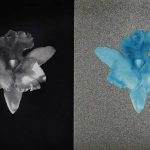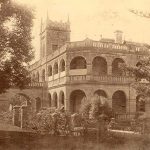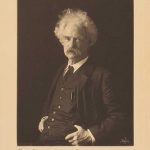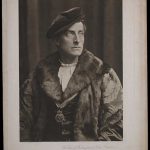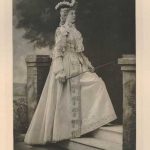Photogravure, also known as heliogravure, is an intaglio printmaking or photo-mechanical process whereby a copper plate is grained (adding a pattern to the plate) and then coated with a light-sensitive gelatin tissue which had been exposed to a film positive, and then etched, resulting in a high quality intaglio plate that can reproduce detailed continuous tones of a photograph.
The earliest forms of photogravure were developed by two original pioneers of photography itself, first Nicéphore Niépce in France in the 1820s, and later Henry Fox Talbot in England. Niépce was seeking a means to create photographic images on plates that could then be etched and used to make prints on paper with a traditional printing press. Niépce’s early images were among the first photographs, pre-dating daguerreotypes and the later wet collodion photographic process. Talbot, inventor of the calotype paper negative process, wanted to make paper prints that would not fade. He worked on his photomechanical process in the 1850s and patented it in 1852 (‘photographic engraving’) and 1858 (‘photoglyphic engraving’).
Photogravure in its mature form was developed in 1878 by Czech painter Karel Klíč, who built on Talbot’s research. This process, the one still in use today, is called the Talbot-Klič process.
Because of its high quality and richness, photogravure was used for both original fine art prints and for photo-reproduction of works from other media such as paintings. Photogravure is distinguished from rotogravure in that photogravure uses a flat copper plate etched rather deeply and printed by hand, while in rotogravure, as the name implies, a rotary cylinder is only lightly etched, and it is a factory printing process for newspapers, magazines, and packaging. In France the correct term for photogravure is héliogravure, while the French term photogravure refers to any photo-based etching technique. Reference: Wikipedia
ALFRED STIEGLITZ (1864–1946) Icy Night, 1898 photogravure, mounted on paper, with original overmat signed and titled in pencil (mount, recto) image: 5 x 6 1/4 in. (12.7 x 15.9 cm.) sheet/overmat: 5 3/4 x 7 in. (14.4 x 17.7 cm.) mount: 8 3/4 x 10 5/8 in. (22.2 x 26.9 cm.)
Sold for USD 15,000 at Christie’s in 2018
[PHOTOGRAVURE] Group of three Camera Work photogravures. Comprises EVANS, FREDERIC H. Ely Cathedral, across the Nave and Octagon, 1903. From Camera Work IV; STIEGLITZ, ALFRED. Snapshot. From my window, New York, 1902. From Camera Work XX; and STEICHEN, EDWARD. Balzac–The Open Sky, 1908. From Camera Work XXXIV/XXXV. Marginal damp stain to the mount of the second work, the image unaffected
Sold for $1,500 (includes buyer’s premium) at Doyle New York in 2019
Robert Mapplethorpe (1946-1989). Photogravure and screenprint diptych, entitled “Tampa Orchid”. Numbered 44/60. Published by Graphicstudio, University of South Florida, Tampa. Print measures 21-1/2″ high x 35-1/4″ wide. Frame measures approx. 27-1/2″ high x 41″ wide. Provenance: From the collection of Iris & E. Stan Salzer, previously on long-term loan to the Museum of Fine Arts, St. Petersburg, Florida.
Sold for $11,000 at Blackwell Auctions in 2018
Photogravure image, Curzon Hall, paper / cardboard, maker unknown, Australia, date unknown. photogravure image depicting Curzon Hall.
Reference: Museum of Applied Art and Sciences
Clemens, Samuel L. A FINE PHOTOGRAVURE PORTRAIT OF CLEMENS, INSCRIBED AND SIGNED (“MARK TWAIN”) TO EDWARD QUINTARD Photogravure half-length portrait of Clemens (13 x 10 1/2 in.; 330 x 268 mm) by Joseph G. Gessford, copyrighted 1904 in the plate and with Gessford’s blindstamp in the upper left margin, inscribed to Quintard, [New York], “New Years, 1905”; verso browned.
Sold for 5,625 USD at Sotheby’s in 2018
Photogravure print of a three-quarters photograph of Johnston Forbes-Robertson as the Duke of Buckingham wearing a soft, flat velvet baker’s boy cap, a fur-trimmed coat with wide fur lapels and brocade sleeves edged in fur, and a white cravat. He wears a medallion on a ribbon which hangs in front of a buttoned satin waistcoat. He is looking upwards and to his left, with an intense and thoughtful expression.
Johnston Forbes-Robertson (1853-1937) was an English actor-manager who made his first stage appearance in 1874 at the Princess’s Theatre, and had a long and varied stage career, despite initially training as an artist. He made his name at the Haymarket Theatre in 1876 and joined the Bancrofts at the Prince of Wales Theatre two years later, having a success in the plays Diplomacy, Duty and Ours. In 1882 he went to the Lyceum Theatre under Henry Irving and went into management there in 1895 where he played Romeo to the Juliet of Mrs. Patrick Campbell, and in 1897 Hamlet to her Ophelia. Forbes-Robertson was considered to be one of the greatest Hamlets of all time, his fine-featured face and superb voice making him an ideal Prince of Denmark. His Buckingham in Shakespeare’s Henry VIII was another of his successful roles. He became a great favourite of the public, at home and in the USA and Canada where he spent many years on tour. He was knighted in 1913 during the last week of his farewell performances at Drury Lane Theatre.
Reference: © Victoria and Albert Museum

![[PHOTOGRAVURE] Group of three Camera Work](https://antiquevintageprints.com/wp-content/uploads/2019/09/photogravure-camera-work-150x150.jpg)
